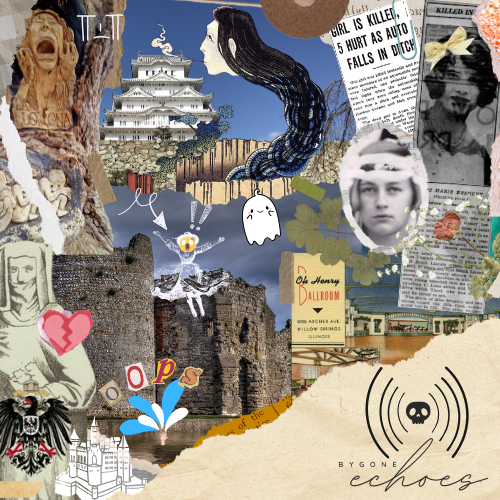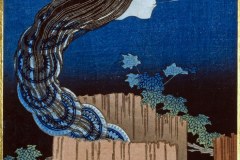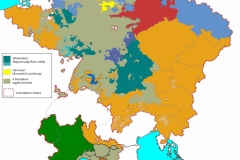The Lady in White World Tour
TLDR; The Lady in White is that girl of ghost stories—tragic, mysterious, and rocking the same white fit for centuries. In England Charlotte White drowned saving her baby, now she’s haunting a castle on repeat. In Japan, Okiku ended up in a well after shutting down a loser who couldn’t take a hint—and she’s still down there, counting to nine. Over in Deutschland, Kunigunde killed her kiddos for a man who ghosted her (literally); now she’s a bad omen for his fam. La Llorona drowned her kids and cries rivers about it, and Resurrection Mary is hitchhiking in Chicago but never actually needs a ride. These ghost gals are more than spooky—they’re reflections of society’s mess: patriarchy, grief, colonization, and unfair expectations on women. Spooky and symbolic? Total ghost goals.
Transcription

⚠️ Trigger Warning ⚠️
Before listening in to this episode of Bygone Echoes, we want to provide a quick content warning for our listeners. This episode discusses ghost stories and folklore that often involve themes of violence, death, suicide, child loss, betrayal, and grief, as well as systemic issues like patriarchy, colonization, and gender-based oppression. While these tales are rooted in history and cultural critique, they can be emotionally heavy for some listeners.
If these topics feel like they might be too much for you today–thats totally ok. Please take care of yourself, and feel free to skip this episode or revisit it when you’re ready. Your well-being is the priority!
Hey there history and mystery lovers! Welcome to Bygone Echoes, a history podcast where we dig up the past, shake off the cobwebs, and maybe unearth a ghost or two. I’m your host, Courtney, and today, we’re chatting about one of the most haunting and persistent figures in spooky folklore: the Lady in White. You know who I mean: that mysterious feminine figure in flowing white who seems to show up in every culture’s tragic ghost story.
Now, I’ve always had a soft spot for ghost stories. They’re creepy, yes, but they’re also oddly comforting. Think about it—these stories are like little time capsules of human emotion that we’ve been passing around the proverbial campfire for generations. And yes, they’re meant to give us goosebumps, but the best ones? They’re about love, loss, and all those messy human feelings we’re still trying to figure out. These stories are not just spooky—they’re human.
And okay, seriously, I’m not saying I’m ready to host a séance in my living room, I do not own a Ouiji board–but I do own a set of super cute tarot cards– but…there’s a part of me that likes to leave the door open for the possibility of ghosts and the supernatural. Like, do I believe there’s a spectral woman hitchhiking on Chicago’s Archer Avenue? Not really. Do I find it oddly reassuring that so many people believe they’ve seen her for decades now? Absolutely. It’s proof that we’re still curious, still looking for meaning, still trying to make sense of the world—and that’s kind of beautiful, don’t you think?
For me, the Lady in White is the MVP of spooky folklore because she does show up in one form or another across time and anywhere humans call home. But why is this figure always a woman? Why is she always associated with the color white? Why is her story always linked to tragedy?
And that’s part of what makes her so haunting. She’s not just a ghostly figure in a flowing dress—she’s a glimpse into the fears we’ve carried, the pain we’ve romanticized, and the stories we’ve told ourselves about women, tragedy, and justice. She’s a shadowy thread that ties together centuries of folklore, stretching from lonely highways to castle battlements, from misty forests to moonlit cemeteries.
Whether you believe in ghosts or just love a good story, I promise there’s something here for you. Because even if the Lady in White isn’t real, the meaning behind her definitely is.
This episode is a little different from our usual format. Instead of one long story, we’re going on a ghost story road trip around the world.
We’ll be walking the halls of a mist-shrouded English castle, where every creaking floorboard has a story. We’ll venture into an ancient Japanese temple, where ghost stories aren’t just tales—they’re an art form that’ll make your spine tingle in ways our Western versions never quite manage. Then we’ll explore Germany, where folklore runs as thick as the Black Forest itself, before finally circling back home to America’s haunted highways and battle fields, where our Lady in White still catches the occasional midnight ride.
Then, we’ll step back, analyze what these stories mean, and explore how they reflect our shared fears, values, and history.
So grab a cozy blanket, turn on a light—or don’t, if you’re feeling brave—and let’s explore the hauntingly global tale of the Lady in White.
“The mist coiled around me, clinging like cold hands as I wandered the grounds of Portchester Castle. Its ancient walls loomed, heavy with centuries of whispers, their stones steeped in grief. The moat below glistened faintly, a shard of moonlight trapped in its unnatural stillness.
Then I saw her.
She moved along the battlements, a spectral figure in white that shimmered and faded with the mist. Her dress clung to her as if drenched, water pooling at her feet with every step. Her face—it wasn’t anger or fear, but a sorrow so deep it seized my breath. I couldn’t move.
She paused at the wall’s edge, tilting her head as though listening for something lost. My pulse quickened as she stepped forward, her figure dissolving into the air like smoke, vanishing into the moat below.
I ran to the edge, my heart pounding in my ears. No splash, no ripples—just the moat’s glassy surface, unbroken, reflecting the pale, pitiless moon.
The silence pressed in, but it wasn’t empty. It watched me, ancient and knowing.
Charlotte White. The White Lady of Portchester. The story clawed at my memory—how she had thrown herself into the moat, sacrificing everything to save her child. Her love became her curse, trapping her here, bound to relive the moment of her death.
A whisper brushed my ear, soft as a dying breath. “Why didn’t you stop me?”
My blood froze. I spun around, the mist swirling in my wake.
There was nothing. Only the mist, and the weight of her sorrow lingering in the air.”
Portchester Castle is perched on the northern shore of Portsmouth Harbour in Hampshire, England, it’s a place where history feels alive in every weathered stone. Thanks to its waterside location, it was a prime spot for keeping an eye on anyone who might’ve been tempted to invade.
The Romans built a fort on the site in the 3rd century, and the impressive walls still stand today. After the Romans came the Anglo-Saxons, then the Normans in 1066. They reimagined the site as a medieval castle and over time, it became a royal residence and then a hub for local governance.
By the Victorian era, when Charlotte White’s story unfolds, Portchester Castle had left its days of royalty and defense behind. Instead, it became a peaceful landmark, its imposing walls standing as reminders of England’s long and complicated history.
But for all its historical appeal, the castle had a darker, more mysterious side. Its deep moat and quiet, shadowy corners seemed to carry whispers of something unsettled. It was the perfect backdrop for a story like Charlotte White’s, one of tragedy and lingering sorrow.
According to legend, Charlotte was a mother living near the castle during the Victorian era. One day, while walking with her baby near the castle’s moat, disaster struck—her child fell into the cold, dark water.
Without hesitation, Charlotte dove in after her baby. But the moat was deep, and the waters were treacherous. Despite her desperate attempts, neither mother nor child survived.
But her story doesn’t end there. Locals say Charlotte’s ghost still haunts the castle grounds. Visitors have described seeing a pale, white-clad figure gliding along the battlements, silent and sorrowful, before leaping into the moat. This ghostly leap, they say, echoes the final, heart-wrenching act of her life. Those who encounter her speak of an overwhelming sadness that lingers long after she vanishes.
Charlotte White’s story lingers with you because it hits on something so universal: loss, tragedy, and the all-consuming love of a mother. The image of a woman risking everything to save her child doesn’t just tug at our heartstrings—it yanks them. It’s the kind of tale that transcends time and culture because it’s so achingly human.
The Victorian era, when Charlotte’s legend took shape, had a lot to say about motherhood. Women were expected to be caregivers and moral anchors, their whole identity wrapped up in their family’s well-being. Charlotte’s desperate leap to save her baby fits perfectly into those ideals of self-sacrificing motherhood. But her story also points to something darker: the fragility of life in a time when danger and loss loomed around every corner.
And then there’s the setting—Portchester Castle. With its weathered walls and ghostly moat, it feels tailor-made for a story like Charlotte’s. Castles symbolize strength and endurance, but Charlotte’s tragedy flips that script. Her presence reminds us that even the strongest fortresses can’t shield us from the raw pain of human loss.
The part that really gets me, though? The leap. Witnesses say her ghost endlessly relives that heartbreaking moment, diving into the moat in a desperate act of love. It’s not just a spooky apparition; it’s a symbol of grief so deep it refuses to fade. And, of course, she’s wearing white—because in stories like this, white always carries a double meaning: purity and mourning.
Portchester Castle might be best known for its medieval roots and ghostly legends but its walls have witnessed more than myths. They hold stories that stretch far beyond knights and royalty, rooted in the complexities of global history. And I’d like to share one such story, just because I found it so interesting.
In 1796, Britain and France were fighting, per usual, and the fighting extended to the French colonies. This is also while the Haitian Revolution is on and poppin.
During this chaos, Britain captured over 2,500 prisoners of war from islands like St. Lucia. Among them were over 300 white prisoners, but the majority were Black or mixed-race soldiers and their wives and children. Many of these men had fought for France during this conflict with Britain in exchange for promises of freedom after slavery was abolished there in 1794. Think about that: people who had just gained liberty fighting to protect it, only to be swept up in this global conflict.
After their capture, the prisoners were transported to England and confined at Portchester Castle. And here’s where things get even tougher—imagine being dressed for the Caribbean, suddenly stuck in your first English winter. It’s like when you travel and don’t pack for the season, except this isn’t just forgetting a jacket; it’s survival-level unpreparedness.
But the challenges didn’t stop there. White French officers often got parole, meaning they could live relatively freely with some restrictions. Black and mixed-race officers and their families, though? They endured much harsher conditions. I know, I’m oversimplifying this to the extreme, but I really found this tidbit of history interesting.
Some prisoners were eventually exchanged and sent to France, others joined the French army’s Black Pioneer Battalion, and some returned to the Caribbean, only to face Napoleon’s reinstatement of slavery just a few years later.
What stands out to me is that this wasn’t just a European story. These were people fighting for freedom in the Caribbean, many trying to protect the liberty they had just gained. Imagine ending up in an English castle, thousands of miles from home, swept up in the chaos of revolution and colonialism. History really is messy, and complicated, and so deeply human.
It reminds me that while ghost stories are amazing, places like Portchester are also shaped by real lives and struggles—stories that deserve to be remembered, too.
The night clung to me as I reached the well just beyond the south wall of Himeji Castle. They called it Okiku’s Well, where centuries of whispers said her voice still rose with the night. The air was still, as though even the wind was afraid. The stones around the well were worn smooth, their cracks filled with moss older than the stories.
I leaned over the rim, the blackness below swallowing the weak glow of my lantern. The depth seemed endless, a void that drank in the light. I told myself it was just a legend, but the tension in the air said otherwise.
Then, it began.
“One… two… three…”
The voice rose softly, coming from everywhere and nowhere. It was steady and calm, yet it coiled around me, suffocating in its sadness. My chest grew tight, my breaths shallow as the counting continued, each number heavier than the last.
“Four… five… six… seven… eight… nine…”
The pause after nine was unbearable. The stories rushed back to me—travelers who came too close to the well and heard her counting. Farmers who swore the silence after nine lingered in their dreams. Visitors who spoke of her voice following them long after they’d left the castle grounds. They all said the same: someone had to say it.
“T-ten,” I whispered, my voice trembling.
The night shifted, growing deeper, heavier. The weight pressing on me lifted, but the air felt alive, charged, like the world itself was watching. I staggered back, the ground unsteady beneath my feet. The well was silent now, but it wasn’t peace—it was waiting.
I turned and ran, the shadows seeming to stretch toward me. I didn’t look back. They said her story ended at the well, but the silence that followed me felt like it would never let me go.
Himeji Castle, or as it’s more poetically known, the “White Heron Castle,” is one of Japan’s most iconic landmarks. With its gleaming white walls and graceful design, it looks more like a vision from a dream than a fortress. But behind its beauty lies a darker tale—the haunting story of Okiku and the infamous well that bears her name.
Okiku’s story has many versions, even inspiring a kabuki play, and none of them end well (no pun intended). One of the most popular tells of a samurai who became obsessed with her. Okiku was a maid in his household, loyal and virtuous, and she wanted nothing to do with him. Enraged by her refusals, the samurai accused her of losing one of ten priceless plates—a crime that could be punishable by death. He offered her an impossible choice: submit to him, and he’d forgive the “missing” plate. Okiku stood firm, refusing to sacrifice her dignity, and for that, he tortured and killed her, throwing her body into a well. In the kabuki play, she throws herself into the well in despair and drowns.
Another version ties her fate directly to Himeji Castle. In this telling, Okiku served a retainer named Aoyama Tessan, who was plotting treachery against his lord. She overheard his scheme and warned her lover, a loyal samurai, ruining Aoyama’s plans. In revenge, Aoyama accused her of stealing one of ten treasured dishes and subjected her to relentless torment before killing her and discarding her body in the castle’s well.
Yet, her tale is deeply and uniquely Japanese, grounded in the spiritual beliefs of yūrei—ghosts whose grudges tether them to the mortal world. Unlike Western tales, where white often symbolizes purity or mourning, Okiku’s white kimono is a shroud of death, reflecting Japan’s funeral traditions. This detail roots her story in the customs of feudal Japan, where societal norms often left women like Okiku vulnerable to systemic betrayal.
Okiku’s story can be described as a mirror held up to feudal Japan, reflecting rigid hierarchies, unchecked power, and the cost of defiance. Whether she’s the loyal maid rejecting a samurai’s advances or the brave woman exposing treachery, Okiku’s tale is about integrity, resistance, and what happens when someone challenges a system designed to crush them.
In feudal Japan, honor wasn’t just important—it was everything. For women like Okiku, especially maids, life hung by a thread, controlled by the whims of powerful men. Her refusal to submit wasn’t just personal; it was a revolutionary act in a society that demanded her silence. Her punishment? Brutal, disproportionate, and more about obliterating her defiance than any concept of justice.
Himeji Castle, with its gleaming white walls and serene grounds, seems like the opposite of Okiku’s violent end. But the well where her body was discarded tells a darker story. Okiku’s ghost, eternally counting plates, isn’t just spooky—it’s symbolic. That missing tenth plate? It represents betrayal, suffering, and the gaping wounds of injustice. Her restless spirit is a reminder of the wrongs that can’t be erased.
What makes her tale so haunting isn’t just her wails—it’s her persistence. In life, she refused to be silenced; in death, she’s impossible to ignore. Himeji Castle may be a masterpiece of architecture, but Okiku’s story ensures it’s also a testament to those who stood against oppression and paid the price. Her tragedy isn’t just hers—it’s a reminder of the systems that allowed it and the courage it takes to fight them.
The air was alive, charged like a storm about to break. My footsteps were soundless as I wandered the halls of Hohenzollern Castle, swallowed by the heavy silence that clung to the stones. I wasn’t sure what had drawn me here at this hour, but something in the air—a pull, an ache—would not let me stay away.
Then she came.
Her figure emerged as if from mist, draped in white that shimmered as though woven from starlight. Her face was a mask of quiet devastation, and her presence rippled through the air like a wave. I felt her sorrow before I understood it—a dense, aching weight that pressed against my chest, made my breath come shallow and my legs tremble.
She glided forward, her movements fluid yet trembling, like she was both here and not, caught between worlds. I wanted to turn away, but her grief—her overwhelming, suffocating grief—rooted me in place. It wasn’t just hers. It was mine, and the castle’s, and the land’s. It was ancestral, elemental, a part of the very foundation beneath me.
Her gaze flicked toward me, but it wasn’t a meeting of eyes. It was a collision. In that instant, I saw it all—her love twisted into betrayal, her sacrifice distorted into chains, her humanity undone by forces far beyond her control. She wasn’t simply a ghost; she was an echo, a scar left by time itself. And now I was caught in her resonance.
She turned, moving toward the far end of the hall. Her hand lifted as if reaching for something—or someone—but it wavered, her gesture incomplete. Her form flickered, and then she was gone, dissolving into the mist as though she had never been there.
The castle exhaled, and I realized I’d been holding my breath. But the weight in the air remained. Her story wasn’t finished. I could feel it in my bones.
Somewhere in the distance, the first notes of the castle bells began to toll.
Hohenzollern Castle, perched majestically atop Mount Hohenzollern in the Swabian Alps, stands as a symbol of enduring legacy and architectural grandeur. It serves as the ancestral seat of the Hohenzollern family, a dynasty that rose to prominence as rulers of Prussia and later the German Empire. The castle we see today, a neo-Gothic marvel completed in the mid-19th century under King Frederick William IV of Prussia, is the third iteration on this site, following earlier structures dating back to the 11th century.
Yet, beyond its imposing walls lies a haunting legend that has shadowed the Hohenzollern family for centuries—the tale of the White Lady.
The White Lady is often identified as Kunigunde von Orlamünde, a 14th-century widowed noblewoman. According to legend, Kunigunde fell deeply in love with Albrecht von Hohenzollern. When Albrecht cryptically remarked that “four eyes” stood between them—referring to his disapproving parents, she was previously married and already had two young children—Kunigunde tragically misinterpreted his words. Believing he meant her children, she murdered them in a desperate attempt to be with Albrecht. Her horrific act condemned her to eternal unrest, and Albrecht went on to marry someone else. Her spirit, draped in white, is said to wander Hohenzollern Castle and other family estates.
But this Lady in White is more than a ghost; she is a harbinger of death for the Hohenzollern family. Historical accounts recount her frequent appearances in Berlin’s Old Palace during the years 1652 and 1653, each sighting believed to signal an impending family tragedy. Over the years, she has become an enduring symbol of the family’s mystique, her presence adding a spectral layer to their dramatic history.
While the legend of the White Lady captivates with its eerie details, historical records cast doubt on its specifics. The real Kunigunde von Orlamünde, though a notable figure, is not believed to have had children, making the central tragedy of the tale more folklore than fact. Still, the story has endured for centuries, weaving itself into the cultural fabric of the Hohenzollern family and their ancestral lands.
The White Lady’s tale is a medieval soap opera stuffed with betrayal, tragedy, and enough supernatural flair to keep her legend alive for centuries. Rooted in the history of the powerful Hohenzollern dynasty, her story wrestles with ambition, guilt, and the devastating consequences of love gone very, very wrong.
Legend has it she was Kunigunde von Orlamünde, a noblewoman who fell hard for Albrecht von Hohenzollern. But love and medieval communication don’t mix. When Albrecht cryptically mentioned “four eyes” standing in their way, Kunigunde tragically misread the room and assumed he meant her children. She killed them to clear the path for their union—a choice that doomed her in life and afterlife. Historically, Kunigunde didn’t have children, which makes the addition of this detail a deliberate choice. By turning her into a failed mother, the story amplifies the emotional stakes, transforming her into a cautionary figure for ambition and a reflection of societal anxieties about women stepping outside their roles.
Her ghost, draped in white, is said to haunt Hohenzollern Castle and other family estates, appearing as a harbinger of death. But her haunting isn’t just about fear—it embodies the weight of guilt and the dark consequences of love twisted by patriarchal pressures. The imagined crime of infanticide ties her tragedy to universal fears of maternal failure, ensuring her story remains hauntingly relevant.
Hohenzollern Castle, with its neo-Gothic splendor, stands as a monument to power and resilience. Yet the White Lady’s tale reminds us that no legacy is free from shadows. She’s not just a spooky harbinger of death; she’s a walking (floating?) reminder of how unchecked ambition can turn love into destruction.
And here’s the kicker—her power doesn’t lie in whether her story is true. It’s in what it makes us feel. Kunigunde’s tale taps into universal fears: guilt that won’t let go, the ripple effects of our choices, and how the past has a way of showing up uninvited. Whether she’s a literal ghost or a symbolic warning, the White Lady remains forever woven into the mystique of Hohenzollern Castle. And let’s be honest: who doesn’t love a ghost with layers?
The river held its own kind of magic, pulling us closer even as the sun began to sink and shadows stretched long and thin. We were just kids—cousins laughing too loud, daring each other to throw stones farther, to stay longer.
Abuela’s words echoed in my mind: “Don’t play by the river when the sun is low. That’s when La Llorona roams.” But the air felt alive, thick with something we didn’t yet understand. So, we stayed.
The first cry came soft, almost a sigh carried on the wind. It brushed against my skin, cold and heavy, and the laughter caught in my throat. We froze, our joy swallowed by the sound. It wasn’t an animal. It wasn’t the wind. It was something else—something that didn’t belong. I turned toward it, and there she was.
She stood on the far bank, her figure draped in white that shimmered faintly, bending the light around her. Her face was hidden beneath dark, tangled hair, but her presence spoke louder than words. It wasn’t just her sorrow that I felt; it was her love, twisted and sharp, reaching out for something lost.
She moved then, not walking but gliding, the air bending around her as though she didn’t belong to this world anymore. Her cries grew louder, a lament that pressed against my chest and filled my lungs with something I couldn’t name. Her grief became mine—raw, unrelenting.
Someone whispered, “Run.”
The spell broke. We tore through the trees, her cries tearing at our backs, louder, closer, until it felt like the whole forest was wailing with her. I could swear I heard her wail, “¡Ay, mis hijos!”, just like in the story.
When we reached home, shaking and breathless, Abuela was already waiting. She didn’t ask where we’d been. She just crossed herself, her hand steady, her eyes distant, as if she too could hear the wails clinging to us.
That night, the river was restless, its voice tangled with hers. I couldn’t sleep. Her cries clung to me, filling the air with a grief that had no end, no beginning.
We never went back to the river at dusk. It wasn’t just a place anymore—it was a story, a truth that lived and breathed, as real as the sorrow that clung to her wail.
La Llorona—a ghost story so famous it echoes across Mexico, the American Southwest, and Latin America—has haunted riversides and imaginations for centuries. Her roots run deep, blending Aztec mythology with Spanish colonial influence. Some even connect her to La Malinche, the controversial figure who aided Hernán Cortés during the Spanish conquest. Like La Llorona, La Malinche is often painted as both a victim and a villain—a woman caught between cultures and expectations.
The most well-known version of La Llorona’s tale begins with Maria, a stunningly beautiful woman who seemed to have it all: a handsome, wealthy husband, children, and social status. But when her husband betrayed and abandoned her, Maria’s grief turned to fury. In an unthinkable act, she drowned her children in a river. Consumed by guilt, she took her own life, but instead of finding peace, she became a restless spirit, doomed to wander in search of her children. If you hear her mournful cry—you might want to run. I don’t speak Spanish, clearly, and I don’t want to butcher anymore languages today, so the phase La Llorna is known to say can be translated to: “Oh, my children! Where are my children?”
La Llorona’s legend has endured for generations because it isn’t just a scary story—it’s a living, breathing part of Mexican culture. It’s still told today, I read tons of stories online of people playfully using it to spook younger siblings or cousins. Her legend is alive in the stories people tell, in warnings whispered over campfires, and in the way her wails can make the hairs on your neck stand on end.
Though her legend is most famous in Mexico, La Llorona’s influence stretches from Guatemala to the American Southwest, with some really fascinating regional twists. In some versions, she’s a vengeful specter hunting unfaithful men; in others, she’s a guardian spirit protecting children. These variations often reflect the distinct cultural or geographic influences of the regions where her story has taken root, adding unique layers of meaning.
Modern pop culture has embraced her too, though not always with the depth her story deserves. Films like The Curse of La Llorona have brought her eerie wails to the big screen, but those glossy Hollywood versions often miss the richness of her cultural and historical origins. Her power doesn’t just lie in the chills she gives—it’s in the way her story connects the past to the present, carrying the weight of centuries of grief, love, and loss.
La Llorona is a cultural icon loaded with meaning. Her story reflects the painful collision of Indigenous and colonial histories, especially when we connect her to another complex figure: La Malinche. And oh, La Malinche. The way history has treated her? A hot mess, to say the least.
La Malinche’s story is much deeper than any of the history classes I took in school led me to believe. She was born Malinalli, a Nahua girl of noble lineage—basically a princess by today’s standards. Her education was impressive: she was groomed in diplomacy, language, and culture. Not to empower her, but to make her a useful pawn for alliances between powerful men. That was the deal for noble girls back then—your value wasn’t in who you were, but what you could do for your family, and most importantly, for the men in your life.
But then life for Malinalli took a sharp left turn. At some point, she was sold into slavery. According to some sources—and this part sounds straight out of a telenovela—her stepmother orchestrated her enslavement to make sure her own son would inherit Malinalli’s claim to power.
Like, we’re talking kidnapping an 8-year-old girl, holding a fake funeral using another child’s body, and then trafficking Malinalli to a different region. Whether or not that part’s true, we do know that young Malinalli went from a life of privilege and promise to one of enslavement. It had to have been a bleak existence, and it sounds like she was traded among many men. By the time she was about 19 years old, her enslavers offered her and 20 other enslaved women to the invading Hernán Cortés as a peace offering.
She used the tools she had—her intelligence, her education, her knowledge of various languages and cultures, and yes, even her body—to carve out some measure of power in a system that gave her none. And let me just say this: her “relationship” with Cortés wasn’t what anyone today would call consensual. Seeing her referred to as his mistress while researching this irked me to my soul. As his slave, she was not in a position to refuse him or assert control over her own body. The sexual aspect of their relationship cannot be understood as one of equals—it was shaped by the power dynamics. Colonization, patriarchy, and her status as an enslaved woman. She was a survivor. She used what she had to survive in a brutal colonial system that left her with no good options.
Here’s what struck me as I worked through her story: both La Malinche and La Llorona are remembered as betrayers. La Malinche is branded as the ultimate traitor to her people, while La Llorona is condemned as a mother who killed her own children. Both are defined by loss: Malinche’s role in the cultural erasure brought on by colonization, and La Llorona’s drowning of her children in an act of despair and rage. And both women are forever haunted, their grief reflecting not just personal pain, but the collective agony of a people whose world was ripped apart.
La Llorona’s story also critiques the impossible standards forced on women. María is celebrated as the perfect wife and mother—until her husband’s betrayal breaks her, and she commits the unspeakable act of drowning her children. Her punishment? An eternity of grief, wandering the earth in search of her lost children. The message is chilling: step outside the rules society sets for you, and you’ll pay for it forever. La Malinche’s legacy carries a similar weight: even though she was trapped by a patriarchal, colonial system, her choices, her survival, has been twisted into a cautionary tale about betrayal.
But here’s what we often miss: these women are not just villains or victims. They’re mirrors. They reflect the legacies of colonization, the crushing weight of societal expectations, and the deep, enduring grief of being caught in forces far beyond your control. La Llorona’s wails aren’t just for her children—they’re for an entire way of life destroyed by colonization. Her story is a reminder of how Indigenous people were stripped of their land, culture, and identities, and the grief that still lingers.
And while we’re on the subject of Indigenous culture, let’s address something else we’ve been oversimplifying for far too long. I’ve spent almost all of my life, until about a year ago, thinking the Aztecs were one unified empire—a massive, one-size-fits-all civilization with the same customs, beliefs, staples, fashion, language–the works. Spoiler alert: that’s not true.
The term “Aztec” is a convenient umbrella historians slapped on a much more complex and diverse reality. The people we usually mean when we say “Aztec” are actually the Mexica. They were just one of many Nahua-speaking groups in pre-Columbian Mesoamerica. The region was a vibrant patchwork of cultures and political systems, all vying for influence and power. The Mexica were incredibly influential, yes—but they weren’t the whole story.
And here’s a crucial point: the Mexica and their descendants are also not some long-lost civilization. They’re still here, their language and traditions alive and thriving despite centuries of colonization. So when we talk about the Mexica instead of lumping them under the generic term “Aztec,” we honor their true identity.
This matters because stories like La Llorona’s don’t just live in the past—they echo in the present. Whether she’s seen as a tragic mother, a vengeful ghost, or a protector of children, her legend continues to hold power. La Llorona reminds us of the grief and survival that come with colonization, of the burdens placed on women, and of the resilience in the stories we pass down. Her cries are a warning, a lesson, and a legacy that’s still alive in the tales we tell today.
My headlights caught her—a pale figure standing by the shoulder, looking straight ahead. I shouldn’t have stopped. I knew better than to stop for strangers.
But seeing her there, all alone on that dark stretch of road, it didn’t sit right with me. A woman walking alone at night? Anything could happen. And if it were me, I’d hope someone would stop.
So, I pulled over.
“Are you okay?” I asked, my voice tight as I cracked the window.
She turned slow, and her eyes met mine. They were silver, glowing faint like something alive.
“I need to get home,” she said, her voice soft but steady.
Every nerve screamed to drive off, but leaving her felt too cruel. Reluctantly, my hand moved to unlock the door. She slid in, quiet as a shadow, her hands resting in her lap.
“Where’s home?”
“South,” she whispered.
We drove in silence. Her hands never moved, and with each mile, the air grew heavier, colder. When I glanced at her in the mirror, her lips moved, but no sound came out.
“Here,” she said suddenly, snapping me out of my thoughts. She pointed to a dirt road that ended at an old iron gate. Beyond it, a graveyard stretched under the moonlight.
“This?” My throat felt tight.
She nodded, then stepped out, walking toward the gates as the fog seemed to swallow her.
She turned once, smiled an eerie smile, then disappeared.
Resurrection Mary has haunted Chicago for nearly a century, but for me, she’s been haunting my mind since childhood. I have a horrible memory—I’ll admit that upfront. But somehow, I vividly remember watching her episode on Unsolved Mysteries.
It was summer break, and I must’ve been around 8 years old. I was sitting there with a bowl of self-prepared ramen noodles, eyes glued to the screen, absolutely mesmerized. The combination of spooky narration, ghostly reenactments, and that eerie theme music sent chills down my spine as I soaked in every detail. Mary wasn’t just a ghost—she became my first real brush with the creepy and mysterious, and I’ve been hooked ever since.
Her legend starts in the 1930s, with Mary—a young woman who loved to dance. One night, after an argument with her boyfriend at the Oh Henry Ballroom (later the Willowbrook Ballroom), she stormed off and decided to walk home along Archer Avenue. But Mary never made it. She was struck and killed by a car, and her grieving parents buried her in Resurrection Cemetery, dressed in her favorite white gown and dancing shoes.
What fascinated me then—and still does—is what came next. Drivers along Archer Avenue began to report seeing a beautiful young woman in a white dress. Some said she was hitchhiking and gave directions to Resurrection Cemetery, only to vanish as they passed its gates. Others saw her walking alone, eerily quiet, before she disappeared into the night. And then there’s the famous 1976 incident, when someone claimed to see a ghostly figure gripping the cemetery gates. The iron bars were found scorched and bent, as if something—or someone—had left its mark.
And then there’s the mystery of her identity. Some believe Resurrection Mary was Anna “Marija” Norkus, a 12-year-old girl who died in a car crash on her way home from the Oh Henry Ballroom in 1927. Others believe the ghost is Mary Bregovy, who was also killed in a car crash in 1934. Both were laid to rest in Resurrection Cemetery, adding an extra layer of intrigue.
As a kid, this story sparked my imagination. Who was Mary? Or is “Mary” several different ghosts? Why was she still wandering Archer Avenue? Could you really encounter her if you drove there late at night? And, naturally, my overly dramatic child brain went here: If I was hit by a car, would I have a story like this someday? Would I be tricking guys into giving me car rides only to ditch before—statistically speaking—anything bad could happen?
Even now, I find myself just as intrigued by her story—part ghost tale, part urban legend, and 100% unforgettable. For me, Resurrection Mary isn’t just Chicago’s ghost; her story is one of the tales that made me fall in love with ghost stories.
Resurrection Mary is a cultural phenomenon that blends history, mystery, and the human fascination with the unknown. As a “vanishing hitchhiker,” her tale taps into universal fears—encountering something ordinary that turns out to be anything but. The specific locations tied to her story, like Archer Avenue and Resurrection Cemetery, make her legend feel chillingly real.
A big part of her allure is the mystery of her identity. Is she Anna “Marija” Norkus, a 12-year-old girl killed in a car accident after a night of dancing in 1927? Or Mary Bregovy, a 21-year-old who died tragically in 1934? Or could she be a combination of both, shaped by Chicago’s collective memory and fascination with untimely deaths? This ambiguity doesn’t weaken the story—it strengthens it, inviting endless speculation and keeping her legend alive.
Mary’s tale also reflects some old-school societal fears about young women and independence. Anna’s father was criticized for letting her dance, while Mary Bregovy’s death turned into a cautionary tale. Both stories remind us how fragile life is—and how people are quick to judge women for living theirs.
For me, Resurrection Mary was my gateway ghost. She’s mysterious, spooky, and just a little too plausible. The fact that we don’t know everything about her is the whole point. It’s what keeps us wondering—and a little freaked out—decades later.
Let’s pause a moment to give a shoutout to some honorable mentions in the world of Lady-in-White lore—because these spectral queens legit deserve their moment!
First up, in Gettysburg, Pennsylvania, we’ve got the Lady in White of Glatfelter Hall. She’s been spotted drifting through the college’s historic building, her story is often tied to tragedy and loss related to the the Civil War.
Now let’s head to East Siberia, where the Maidens of Uley haunt the Uley River. Legend has it these young women were drowned by their own community to protect the village from invaders. Today, their spirits are said to rise from the water, lamenting the lives stolen from them. Is it haunting, tragic, or just plain terrifying? Let’s go with all three.
Over in South Korea, the Cheonyeogwisin—aka the Virgin Ghost—takes haunting to a whole new level. Draped in a white hanbok with her long hair obscuring her face, she’s the stuff of nightmares and K-drama-worthy chills. Sidenote, I LOVE Kdramas! These spirits are said to be young women who died unmarried, their restless souls wandering in search of closure—or maybe just someone to understand their pain.
The Pawnee, an Indigenous people with ancestral ties to the Central Plains of North America, share the Ghost Bride story—a profound narrative reflecting themes of tragic love, encounters with the spirit world, and the importance of honoring spiritual commitments.
Next, in Ireland we have the Bhean Bhán, or White Lady. She’s your classic tragic figure, weeping for lost love or warning of impending doom. Haunting old castles and estates, she’s practically the ghostly patron saint of heartbreak and foreboding.
From battlefield spirits to river maidens, these Ladies in White may not be the headliners, but they’re every bit as haunting—and unforgettable.
At first glance, the Lady in White stories seem like classic ghost tales: a tragic figure doomed to wander, a spooky apparition tied to a specific place. But dig deeper, and these legends reveal something much more profound. They’re not just stories about ghosts—they’re windows into the moral fabric and societal anxieties of their time, offering haunting critiques of the systems that created them.
Take Okiku’s story in Japan. She defied a powerful man and paid with her life. Whether she’s rejecting unwanted advances or exposing treachery, her tale underscores a brutal reality: in feudal Japan, honor was everything, and women were often sacrificed to maintain it. Her punishment wasn’t about justice; it was about erasing her defiance, a stark reminder of the rigid hierarchies that kept women silent and powerless.
Similarly, La Llorona, whose grief-filled cries for her children have terrified generations, reflects cultural expectations placed on women. On one hand, she’s a cautionary tale about maternal failure, echoing impossible standards of motherhood. On the other, she symbolizes rage—at betrayal, abandonment, and the crushing weight of expectations she couldn’t escape. Her eternal punishment feels less about her actions and more about society’s obsession with controlling women’s roles and identities.
Even Charlotte White at Portchester Castle fits this pattern. Her leap into the moat to save her child aligns with Victorian ideals of self-sacrificing motherhood. Yet her ghostly presence lingers as a reminder that no amount of love can shield us from life’s tragedies—or society’s relentless demands on women. Her story bridges the personal and the cultural, calling attention to the emotional toll such ideals impose.
These legends endure because they reflect something timeless: the fear of stepping outside societal norms and the injustice that often follows. But here’s the twist—they’re also acts of defiance. These women may have been silenced in life, but in death, they refuse to be ignored. Their ghosts force us to confront the systems that oppressed them, challenging us to question the values and fears we’ve inherited.
Ultimately, these stories are as much about the cultures that created them as they are about the ghosts themselves. They’re reflections of collective fears, values, and injustices. By haunting us, these figures compel us to face the uncomfortable truths of humanity and history, making them more than legends—they’re enduring critiques of what it means to be human.
The Lady in White phenomenon is, in my opinion, truly spectacular. These tales aren’t just relics of the past; they continue to evolve and resonate in our modern world. You’ll find them around campfires, in history books, and in mainstream media—not just as fictional horror, but as stories that still hold meaning. Even in this day and age, we find ways to connect to them.
From La Llorona’s chilling presence in contemporary films to Resurrection Mary’s enduring place in urban legend lore, these stories remind us that our fears and values are just as relevant today as they were decades, and even centuries ago. By keeping these tales alive, we don’t just honor the past—we reflect on how they challenge societal norms and offer us the chance to reshape the systems they critique.
Now, I could talk about this topic all day. We didn’t even touch much on folklore’s influenbce, and totally missed the impact of fairies and fae, but we’ll save that for another day.
So, what do all these ghostly women in white have to teach us? On the surface, they’re cautionary tales and tragic figures, woven into the folklore of their cultures. But underneath, they’re so much more. These stories are windows into our shared fears, our deepest regrets, and the pressures society has placed on women for generations.
The Lady in White isn’t just a ghost. She’s a reminder of what happens when grief, injustice, and societal expectations collide. She reflects the sacrifices women have been forced to make, the pain of being silenced, and the rage of having no way out. And yet, her persistence—the way she lingers in our stories, our imaginations, and even our dreams—proves she’s not going anywhere.
From Charlotte White diving into the moat for her child to La Llorona wailing by the river, these women may come from different places and times, but they all share the same haunting power: the ability to make us think about what we value, what we fear, and what we’ve failed to change.
Ghost stories are about more than bumps in the night or eerie shadows. They’re about the weight of history, the echoes of injustice, and the truths we sometimes wish we could forget. But if we listen carefully, maybe we can hear more than just a ghostly wail—maybe we can hear a call to do better, to be better.
Thanks for joining me on this haunted journey through time and across the globe. I hope these stories gave you chills, made you think, and maybe even taught you something new about the ghosts that walk among us—and the ones we carry within.
If you enjoyed this episode, don’t forget to like, share, and subscribe to Bygone Echoes. Your support helps us unearth more forgotten stories and keeps the podcast alive—just like these legends! Follow us on social media for updates, sneak peeks, and a little extra history goodness between episodes. And if you’ve got a ghost story of your own, or an idea for a future episode, I’d love to hear it!
Until next time, be kind, be curious, and be ready to make history.
Interested in learning more? We recommend:
- “The Power of Myth” by Joseph Campbell
- “Japanese Ghost Stories” by Lafcadio Hearn
- “La Llorona’s Children: Religion, Life, and Death in the U.S.-Mexican Borderlands” by Luis D. León
- “Haunted Castles of England: True Ghost Stories of England’s Most Famous Castles” by JG Montgomery
- “Spirits of the Place: Buddhism and Lao Religious Culture” by John Clifford Holt
- “The Vanishing Hitchhiker: American Urban Legends and Their Meanings” by Jan Harold Brunvand









